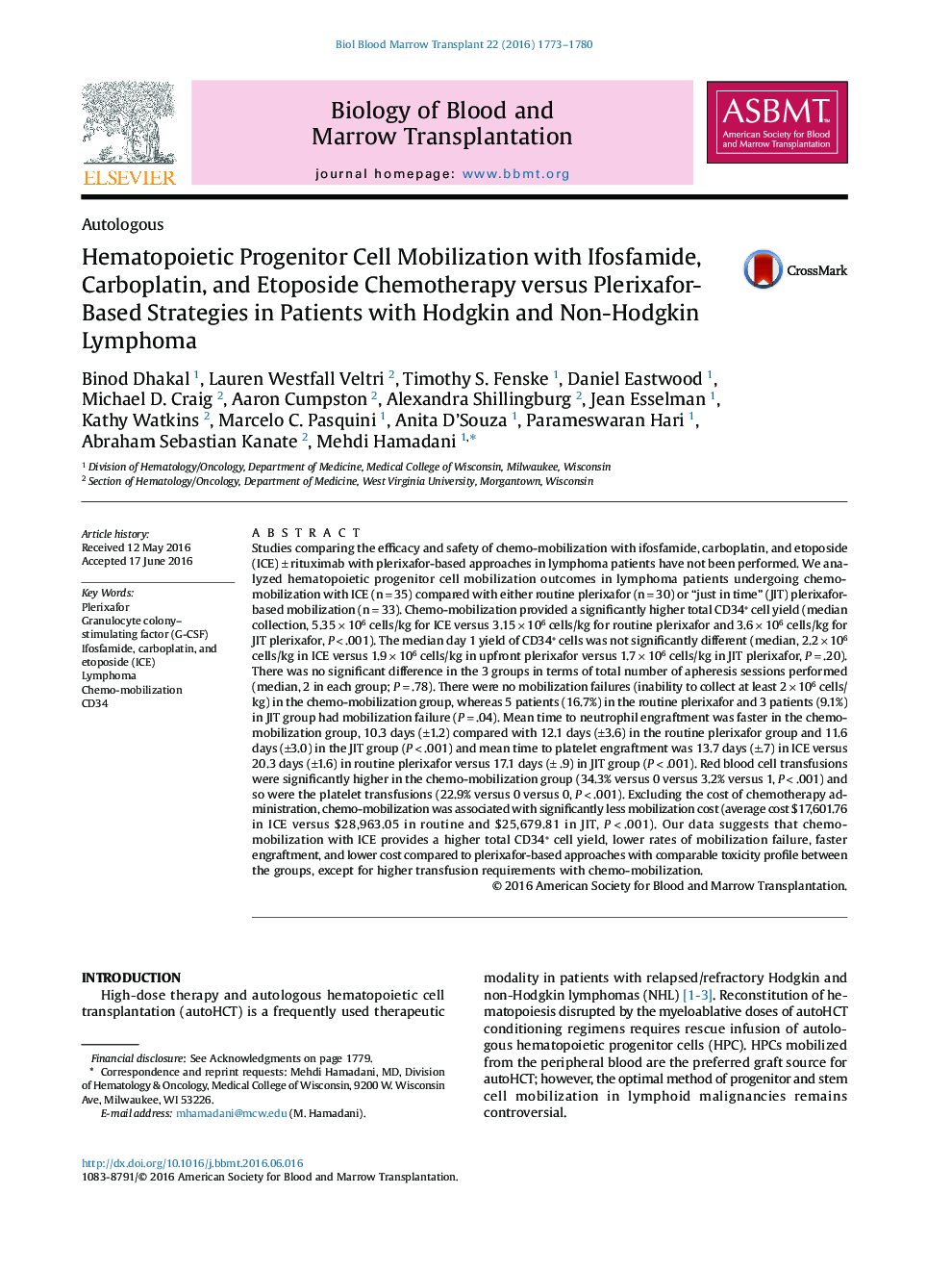| Article ID | Journal | Published Year | Pages | File Type |
|---|---|---|---|---|
| 5524547 | Biology of Blood and Marrow Transplantation | 2016 | 8 Pages |
â¢We performed a comparative analysis of safety and efficacy of chemo-mobilization versus a plerixafor-based approach in 98 lymphoma patientsâ¢Chemo-mobilization provided a significantly higher total CD34+ cell yieldâ¢No difference was seen in the number of apheresis sessionsâ¢Chemo-mobilization was associated with higher transfusion requirements (both platelet and red blood cells) and comparable other toxicitiesâ¢Chemo-mobilization was associated with significantly less total mobilization cost than plerixafor-based approaches
Studies comparing the efficacy and safety of chemo-mobilization with ifosfamide, carboplatin, and etoposide (ICE)â±ârituximab with plerixafor-based approaches in lymphoma patients have not been performed. We analyzed hematopoietic progenitor cell mobilization outcomes in lymphoma patients undergoing chemo-mobilization with ICE (nâ=â35) compared with either routine plerixafor (nâ=â30) or “just in time” (JIT) plerixafor-based mobilization (nâ=â33). Chemo-mobilization provided a significantly higher total CD34+ cell yield (median collection, 5.35 à 106 cells/kg for ICE versus 3.15âÃâ106 cells/kg for routine plerixafor and 3.6âÃâ106 cells/kg for JIT plerixafor, Pâ<â.001). The median day 1 yield of CD34+ cells was not significantly different (median, 2.2âÃâ106 cells/kg in ICE versus 1.9âÃâ106 cells/kg in upfront plerixafor versus 1.7âÃâ106 cells/kg in JIT plerixafor, Pâ=â.20). There was no significant difference in the 3 groups in terms of total number of apheresis sessions performed (median, 2 in each group; Pâ=â.78). There were no mobilization failures (inability to collect at least 2âÃâ106 cells/kg) in the chemo-mobilization group, whereas 5 patients (16.7%) in the routine plerixafor and 3 patients (9.1%) in JIT group had mobilization failure (Pâ=â.04). Mean time to neutrophil engraftment was faster in the chemo-mobilization group, 10.3 days (±1.2) compared with 12.1 days (±3.6) in the routine plerixafor group and 11.6 days (±3.0) in the JIT group (Pâ<â.001) and mean time to platelet engraftment was 13.7 days (±.7) in ICE versus 20.3 days (±1.6) in routine plerixafor versus 17.1 days (± .9) in JIT group (Pâ<â.001). Red blood cell transfusions were significantly higher in the chemo-mobilization group (34.3% versus 0 versus 3.2% versus 1, Pâ<â.001) and so were the platelet transfusions (22.9% versus 0 versus 0, Pâ<â.001). Excluding the cost of chemotherapy administration, chemo-mobilization was associated with significantly less mobilization cost (average cost $17,601.76 in ICE versus $28,963.05 in routine and $25,679.81 in JIT, Pâ<â.001). Our data suggests that chemo-mobilization with ICE provides a higher total CD34+ cell yield, lower rates of mobilization failure, faster engraftment, and lower cost compared to plerixafor-based approaches with comparable toxicity profile between the groups, except for higher transfusion requirements with chemo-mobilization.
